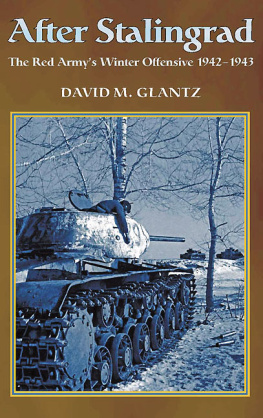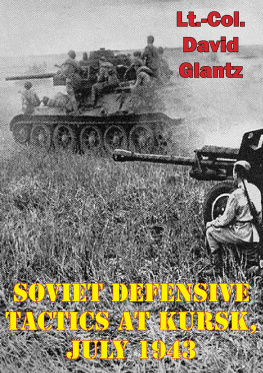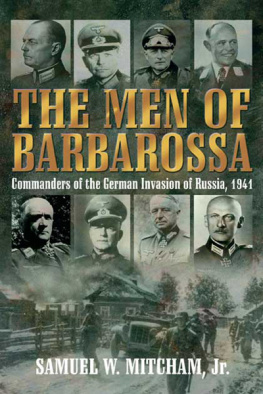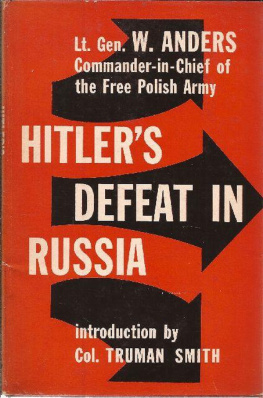
CONTENTS
Appendices
Index
All illustrations are fron the authors collection
The sudden, deep and relentless advance of German forces during Operation Barbarossa has long fascinated military historians and general readers alike. Spearheaded by four powerful panzer groups and protected by an impenetrable curtain of effective air support, the seemingly invincible Wehrmacht advanced from the Soviet Unions western borders to the immediate outskirts of Leningrad, Moscow, and Rostov in the shockingly brief period of less than six months. Historians have described the German advance as a veritable juggernaut; a series of successive offensives culminating in November 1941 with the dramatic but ill-fated attempt to capture Moscow.
As described by Western military historians, the Barbarossa juggernaut began in June and July when the German Army smashed Soviet border defenses and advanced decisively and rapidly along the northwestern, western, and southwestern strategic axes. By early July German forces had shattered Soviet forward defenses, encircled the bulk of three Soviet armies (the 3rd, 4th, and 10th) west of Minsk, and thrust across the Western Dvina and Dnepr rivers, the Soviets second strategic defense line. Once across the two key rivers, the panzer spearheads of German Army Groups North and Centre lunged deep into the Baltic region along the Leningrad axis and toward the key city of Smolensk on the Moscow axis. To the south, Army Group South drove inexorably eastward toward Kiev against heavier Soviet resistance, while German and Rumanian forces soon invaded Moldavia and threatened the Soviet Black Sea port of Odessa.
During Operation Barbarossas second stage in late July and early August, German Army Group North raced through Latvia into Estonia and Soviet territory south of Leningrad, captured the cities of Riga and Pskov, and subsequently pushed northward toward Luga and Novgorod. Simultaneously, Army Group Centre began a month-long struggle for possession of the vital communication centre of Smolensk on the direct road to Moscow. In heavy fighting, the army group partially encircled three Soviet armies (the 16th, 19th, and 20th) in the Smolensk region proper and fended off increasingly strong and desperate Soviet counterattacks to relieve their forces beleaguered near the city. All the while, Army Group South drove eastward toward Kiev, destroyed two Soviet armies (the 6th and 12th) in the Uman region southwest of Kiev, and blockaded Soviet forces in Odessa. This stage ended in late August, when Hitler decided to halt his direct thrusts on Leningrad and Moscow temporarily and, instead, attack and eliminate Soviet forces stubbornly defending Kiev and the central Ukraine.
In Operation Barbarossas third stage, from late August through September, Army Groups Centre and South jointly struck Soviet forces defending in the Kiev region, while other Army Group South forces attacked eastward deeper into the Ukraine. Within a period of two weeks, German forces encircled four of the Soviet Southwestern Fronts armies (the 5th, 21st, 26th and 37th) east and southeast of Kiev. The elimination of the Kiev bulge and its over 600,000 defenders paved the way for the Germans final triumphant drive on Moscow.
The German High Command commenced Operation Typhoon its final assault on Moscow in early October. While Army Groups North and South continued their advance on Leningrad in the north and toward Kharkov and across the Dnepr into the Donbas in the south with reduced forces, the reinforced Army Group Centre mounted a concerted offensive to capture Moscow. Attacking across a broad front from north of Smolensk to south of Briansk, three German panzer groups tore gaping holes through Soviet defenses and quickly encircled five Soviet armies (the 16th 19th, 20th, 24th and 32nd) around Viazma and three Soviet armies (the 50th, 3rd and 13th) north and south of Briansk. Having destroyed the bulk of the Soviet Western, Reserve and Briansk Fronts, by the end of October German forces had captured Rzhev, Kalinin, Viazma, Briansk, Orel, Kaluga and Volokolamsk, Mozhaisk, and Maloiaroslavets on the distant approaches to Moscow. Further south, General Heinz Guderians Second Panzer Army drove eastward through Orel toward Tula, the key to Moscows southern defenses. All the while, an increasingly frantic Stavka threw hastily formed reserves into battle to protect its threatened capital.
After a brief respite prompted by November rains and mud, Operation Typhoon culminated in mid-November when the German High Command attempted to envelop Soviet forces defending Moscow with dramatic armoured thrusts from the north and south. However, in early December 1941, the cumulative effects of time and fate combined to deny the German Army a triumphant end to its six months of near constant victories. Weakened by months of heavy combat in a theatre of war they never really understood, the vaunted Wehrmacht and Luftwaffe finally succumbed to the multiple foes of harsh weather, alien terrain and a fiercely resistant enemy. Amassing its reserve armies, in early December the Stavka halted the German drive within sight of the Moscow Kremlins spires and unleashed a counteroffensive of its own that inflicted unprecedented defeat on Hitlers Wehrmacht.
Western historians have described Operation Barbarossa in panorama, focusing primarily on the notable and the dramatic while ignoring the seemingly mundane incidents that formed the backdrop and context for the more famous and infamous actions. Although they have argued among themselves over the motives, sequencing, timing and objectives associated with each stage of the operation, they have, nevertheless, tended to emphasize the offensives apparently seamless and inexorable nature. This is quite natural, since they lacked Soviet sources. Precious few of these historians have been able to discern Soviet military intent or the full scale of Soviet actions during this period. Lacking Soviet sources and perspectives, these historians have agonized over the paradox that the Wehrmachts string of brilliant offensive successes ended in abject defeat in December 1941.
Today, over fifty years after the wars end, newly available Soviet sources together with more detailed analysis of existing German sources permit us to address and answer many of these and other questions that have frustrated historians for more than half a century.
David M. Glantz
Carlisle, Pennsylvania
January 2001
Plan Barbarossa
In the year of our Lord 1189, Frederick I Barbarossa (Red Beard), Emperor of Germany and self-styled Holy Roman Emperor, took up the cross and led the Third Crusade against Saladins Muslim armies that had just captured Jerusalem. Led by ironclad knights, the armies of Fredericks First Reich swept eastward through Hungary, the Balkans and Asia Minor, intent on liberating Christianitys holy places from infidel control. Over 700 years later, Adolf Hitler, Fhrer of his self-styled German Third Reich, embarked on a fresh crusade, this time against the Soviet Union, the heartland of hated Bolshevism. Inspired by historical precedent, he named his crusade Operation Barbarossa. In place of Fredericks ironclad knights, Hitler spearheaded his crusade with masses of menacing panzers conducting what the world already termed Blitzkrieg (lightning war).
When Hitler began planning Operation Barbarossa in the summer of 1940, Germany had been at war for almost a full year. As had been the case throughout the late 1930s, Hitlers diplomatic and military audacity had exploited his foes weaknesses and timidity, producing victories that belied the real strength of the Wehrmacht (Armed Forces) and Luftwaffe (Air Force). Before the Second World War began on 1 September 1939, Hitlers fledgling armies had reoccupied the Rhineland (1936), annexed Austria (1938), dismembered Czechoslovakia (1938) and annexed Memel (1939), all bloodlessly and with tacit Western approval. Once the war began, Hitlers armies conquered Poland (September 1939), seized Denmark and Norway (April 1940) and vanquished the Wests finest armies to occupy the Netherlands, Belgium and France (May-June 1940), driving the British Army from the continent at Dunkirk in utter defeat. Protected by its formidable moat, the English Channel, and its vaunted High Fleet, Britain survived Hitlers vicious and sustained air attacks during the ensuing Battle of Britain, but only barely.
Next page











